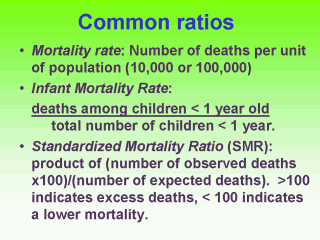| front |1 |2 |3 |4 |5 |6 |7 |8 |9 |10 |11 |12 |13 |14 |15 |16 |17 |18 |19 |20 |21 |22 |23 |24 |25 |review |
 |
Mortality rates are
expressed in different ways: Generally or specifically. The overall mortality rate is the
number of deaths in a given year over the total number in the population. However, as
certain groups are more sensitive indicators of the health of a community than others,
focussing on these particular groups gives us a better idea of the actual level of
community health. The Neonatal MortalityRate (ratio) is the number of deaths in children < 1 month of age over the total number of children < 1 month. The Infant mortality Rate (ratio) is the same proportion but for children under one year of age. This is one of the best indicators of the level of health of a community. Standardization is often used to adjust for the changing structure of the population due to changing fertility, migration or war, in order that apparent changes in incidence, prevalence or mortality arenít mistaken as actual changes in disease occurrence. Age-standardization is the most common form of standardization, with incidence, prevalence or mortality reported for given age bands, rather than the population as a whole. SMRs are used to compare mortality for different segments of the population, such as males vs. females, or people in different occupational groups vs. the workforce as a whole. If the SMR for a group exceeds 100, then that group have greater than expected mortality, and if less than 100 they have lower than expected mortality. Standardization is a general technique that can be used to adjust for the lack of homogeneity or consistency in the structure of the population. |